Marvels are innovative structures and things that make one gaze in awe. In today’s world, modern engineering has done amazing deeds when it comes to creating some of the world’s rarest marvels. Engineering has created structures that have the potential to affect Earth’s movements. There are also structures that are environmentally sustainable. Here, we look at few such mind-boggling modern engineering feats from across the world.
10 Mind-Boggling Modern Engineering Feats Across the World

1. The Three Gorges Dam is so big that it has the capacity to slow the rotation of the earth by strategically shifting significant masses of water. It is one-and-a-half miles wide, over 600-feet wide, and almost 400 miles long. This innovative engineering feat creates electricity equal to 18 nuclear power plants.

The Three Gorges Dam is one of the most amazing feats that engineering has achieved in modern times. The dam is 181 m (594 ft) in height and 2,335 m (7,661 ft) in length, with a crest that’s 40 m (131 ft) wide and a base that’s 115 m (377 ft) wide. It has the capacity to shift 16,000 cubic meters (4,100,000 cubic feet) of water! The dam produces over 20,000 megawatts of hydroelectricity. This number is 20 times more than that of Hoover Dam and is equal to the electricity produced by 18 nuclear power plants. In its full capacity, the Three Gorges Dam would be enough to fulfill 10% of China’s power requirements.
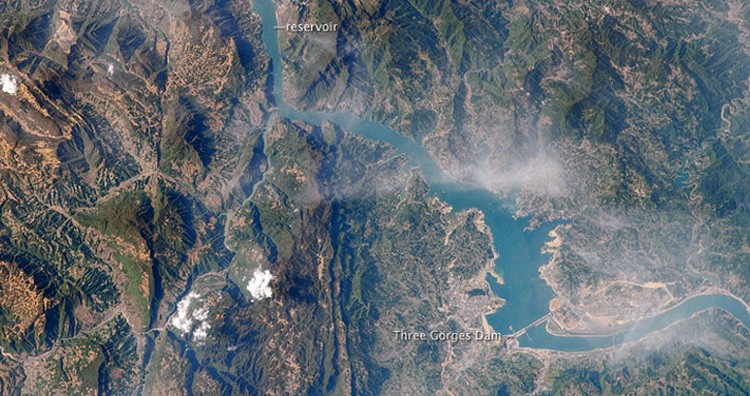
The dam is so gigantic that it has the ability to affect the Earth’s rotation itself. Scientists in NASA calculated that the shifting of the large mass of water by the dam can eventually increase the length of a day by 0.06 microseconds. This would also make the Earth rounder around the middle and flatter on the poles.
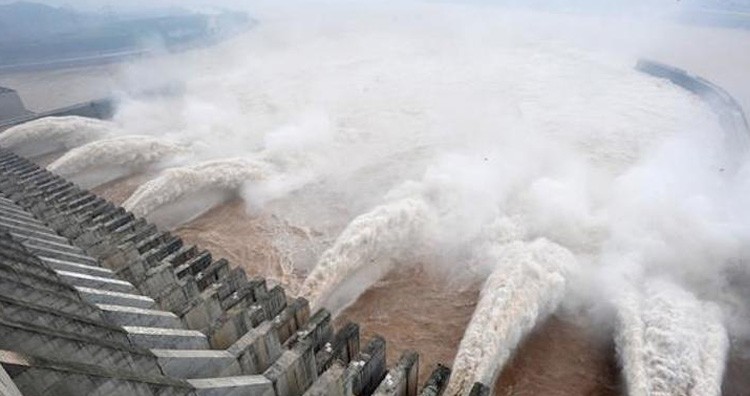
Despite all the advantages of the dam, it has not been excluded from controversies. There are concerns regarding the environmental impacts by the dam like landslides and earthquakes, along with the forced relocation of about 1.3 million people. Environmentalists are also concerned that the dam would lead to more pollution and degradation of water quality along with affecting aquatic lives. (1, 2)
2. Capital Gate is a 35-story skyscraper that leans a full 18 degrees – four times more than that of the Leaning Tower of Pisa. Engineers had to drill 490 piles almost 30 meters into the ground to make it the farthest-leaning building.
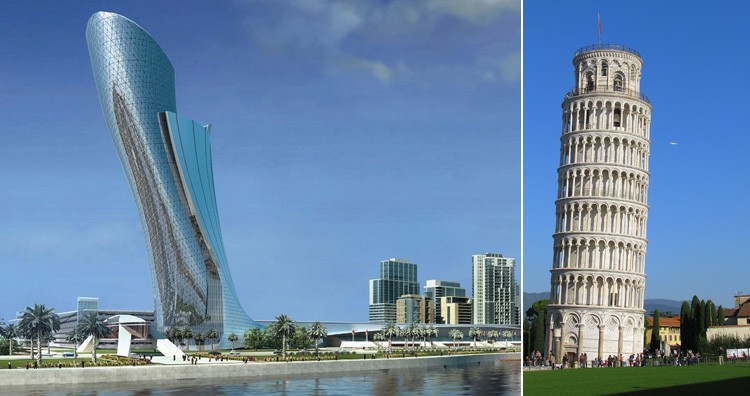
The Capital Gate Tower is the most-inclined building in the world. It’s four times more inclined than the famous Leaning Tower of Pisa and has 35 floors with a height of 160 meters. And the best part is that this building is not just for show. There are offices, retail spaces, and fully-functioning commercial spaces inside the building! The tower also has the Hyatt Capital Gate hotel and a helipad.

Located in Abu Dhabi, UAE, the construction of the building was completed in 2011 on a $231-million budget. The construction procedure utilized for the building is quite impressive and a glorious engineering feat. The building lies above a two-meter-high raft made of concrete. The raft is, in turn, resting upon 490 piles which have been drilled 30 meters underground to withstand the strongest winds, seismic disturbances, and gravitational forces created due to the inclination. The basement for the tower has been constructed with more than 6,000 cubic meters of concrete. The construction of the tower involves the use of 21,500 tons of steel. It has around 8,500 structural steel beams to support the inclination.
The building was designed by an architectural firm by the name of RMJM. (1, 2)
3. The Channel Tunnel is an underwater rail tunnel that links France and England and has 38 km of its tracks underwater. At its lowest point, the tunnel is about 75 meters deep below the surface of the water. Trains travel at 100 miles per hour inside the underwater tunnel.
The Channel Tunnel is the longest underwater train tunnel in the whole world. The entire tunnel is 50 km in length with 38 km of the tunnel lying underwater. The entire system consists of three such tunnels. The tunnels link the towns of Folkestone and Coquelles, which are located in England and France respectively.
All the three tunnels are bored at an average of 40 meters below the sea bed. Trains run on the two, monodirectional tunnels which are connected in between by cross-passages that lead to a service tunnel, a tunnel for maintenance purposes, and an emergency-rescue tunnel. The tunnels have a specially designed vehicle for maintenance operations and for rescue in case of incidents. At its lowest point, the tunnel reaches 75 meters below the sea bed and 115 meters below sea level.
Plans for building the tunnel goes as far back as 1802, but the British government was unwilling to compromise national security. The project became successful in 1988 after being organized by Eurotunnel. Construction was completed in 1994. The final cost amounted to £9 billion ($21 billion), which was way over the proposed budget of £5.5 billion ($13 billion) in 1985. (1, 2)
4. Laerdal Tunnel is a road tunnel that is built within the Hornsnipa and Jeronnosi mountains. The tunnel runs through solid gneiss rock for 15 miles. The design incorporated inputs from psychologists to make the 20-minute drive through the mountain stimulating.
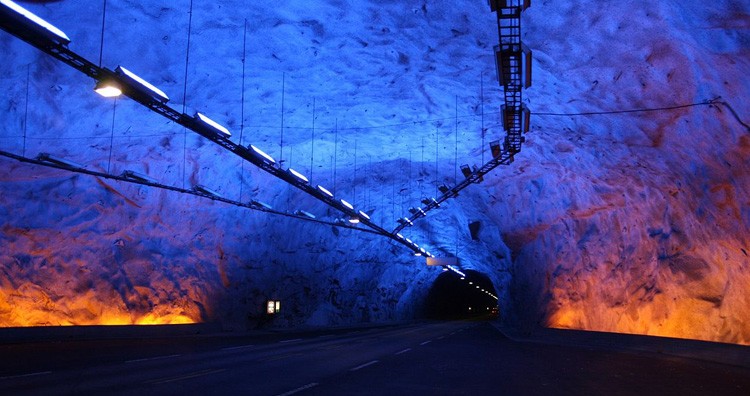
In 1992, the Norwegian government decided to construct a road tunnel that would stretch for 24.5 km making it the longest road tunnel in the world. The officials decided that in order to reduce travel time, they would just create a road that goes through the mountains instead of around them. So, we got the Laerdal Tunnel that was constructed by removing 2,500,000 cubic meters of rocks.

The design team took genuine efforts to make the tunnel as less straining as possible for the drivers. A team of psychologists was brought in to decide the design for the tunnel. The tunnel is divided into four different sections that are separated by three caves. So, while driving through, people can take either section and enjoy the different structures of the cave. This works as a way to break the monotonous routine of driving through on a straight road. Plus, drivers can also stop and rest for a bit inside the caves. The lighting is also different in the caves and gives the impression of sunrise. The entire drive through the tunnel takes 20 minutes.
The tunnels have large fans that purify and ventilate the air. The Laerdal Tunnel is the first in the world equipped with an air treatment system. (1, 2)
5. The Falkirk Wheel in Scotland is a unique, 115-foot-tall boat-lifting and rotating bridge, built with more than 1,200 tons of steel, powered by 10 hydraulic motors, and the ability to lift eight boats at a time. The wheel has the ability to lift a weight equivalent to that of 100 African elephants.

The Falkirk Wheel in Scotland looks like something straight out of an adventure park. In layman terms, the wheel is a huge rotating bridge that lifts up boats from one canal, rotates them, and puts the boat on another canal that is at a height of 35 meters above the first canal. The canals in question here are the Forth, Clyde, and the Union Canal. Apparently, they were connected in the 1930s with the help of locks, devices that raise and lower boats. But somehow, the system corroded over time and since then, this is the first time that the canals have been connected. The tunnel was opened for operation in 2002.
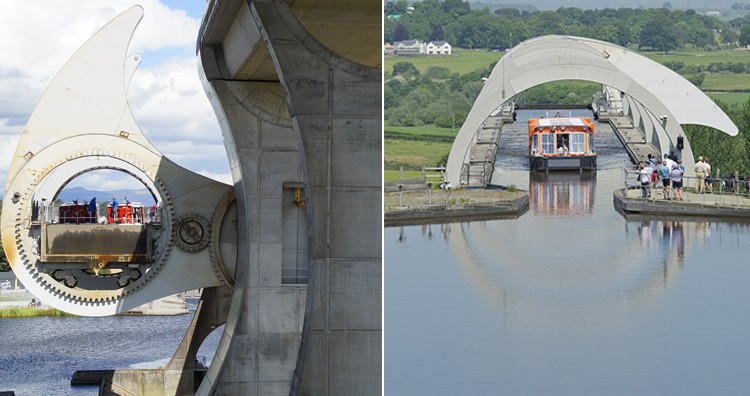
The tunnel has a soaring height of 35 meters and is 27 meters in length. It weighs 1,800 tons in total, with the wheel alone being made of 1,200 tons of steel. The Falkirk Wheel lifts the boats 24 meters. The Union Canal is another 11 meters higher than that. So, after leaving the wheel, the boats are required to pass through a system of locks before finally getting to the Union Canal. (1, 2)
6. The New Valley Project is an enormous irrigation system that has helped to turn half a million acres of desert land into agriculturally viable land. The heart of the project is the Mubarak Pumping Station that pumps water from Lake Nasser via a canal system through the valley transforming over 500,000 acres of desert into agricultural land.

Egypt is one country that has been constantly trying to reform its lands by transforming the barren deserts into agriculturally viable land. The New Valley Project, also known as the “Toshaka Project,” is another such feat. The aim is to change the percentage of inhabitable land from 5% to 25% and turn 588,000 acres of desert into agriculture land.
The New Valley Project aims to create a second Nile Valley that would bring in around 10% of Egypt’s allocated water from the Nile to the valley via a network of irrigation canals. The main canal is supposed to stretch as far as 310 km. As of 2012, the canal was still 60 km short. The heart of the irrigation system is the Mubarak Pumping Station which had its inauguration in 2005.
The work for the project started in 1997. and work is still in progress as of 2019. In 2016, Egyptian President Abdel Fattah el-Sisi revived the project by allocating more land to it. In 2018, Egypt announced that they were working on the biggest date plantation on the Toshaka Project with 2.5 million palm trees. Grapes, wheat, maize, and other fruits and vegetables are also being grown on the project.
There have been a few beneficial by-products of the project which includes the creation of the Toshka Lakes. The lakes now serve as a primary water source for the date plantations. (1, 2, 3)
7. The Melbourne Rectangular Stadium’s roof has been designed by piecing together interlocking polygons to form several geodesic domes, and yet the stadium manages to use 50% less steel than a typical cantilever structure. The stadium uses recycled building material, collects rainwater from the roof, and minimizes power use with an advanced, building-automation system.

Rectangular might not be the right word to describe the stadium when the roof comes into question. Cox Architects + Planners, one of Australia’s best architectural firms, are responsible for the amazing structure. The roof has a geodesic dome that’s made of numerous small triangular shapes that are held together by strips of metal.
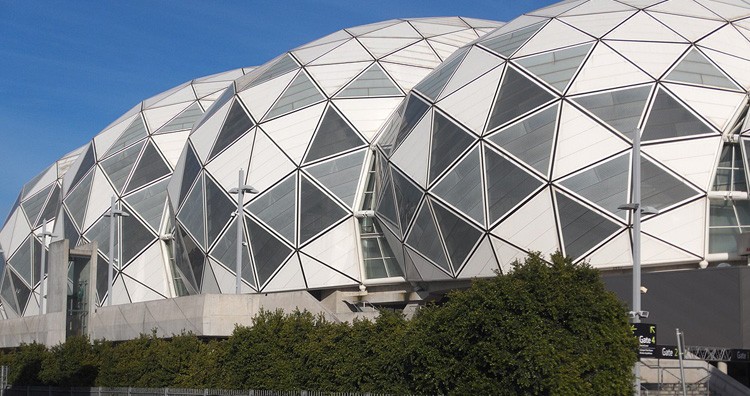
The roof is not only aesthetically pleasing but also effective cost-wise. It uses only half the amount of materials that a typical stadium roof requires. The roof has insulation properties incorporated into it which keeps the conditions under it viable even during the Australian heat. Moreover, the roof is designed to let rainwater run off easily which is then harvested and used as service water in the stadium. (1, 2)
8. The Ericsson Globe is the biggest spherical building in the world with a diameter of 361 feet, an inner height of 279 feet, and a volume of 21,188,800 cubic feet.

The Ericsson Globe, which was originally known as “Stockholm Globe Arena” at the time of its inception, has been the most iconic building in all of Stockholm since its public inauguration in 1989. The capacity of the building is 605,000 cubic meters making it the largest spherical building in the world. The building primarily serves as the arena for Sweden’s national hockey team. It also hosts other concerts and events. Throughout the year, world-famous artists grace the stage at the Ericsson Globe with their performances. A few of them are Metallica, The Rolling Stones, Madonna, Beyoncé, and U2.
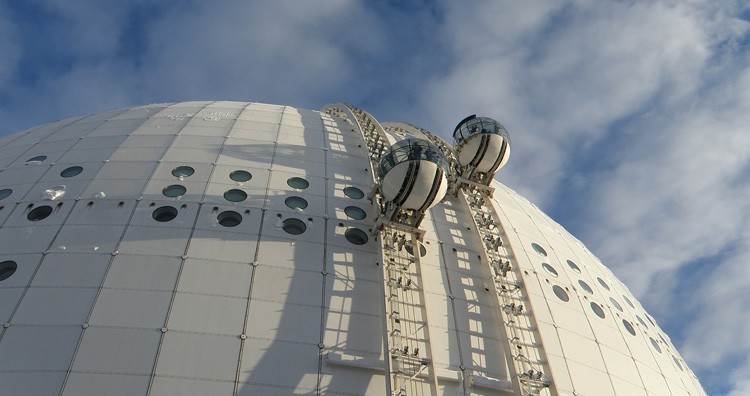
The globe has an exterior elevator called “Skyview” that transports tourists to the topmost point in the arena for an obstructed view of the city. The elevator has two spherical gondolas that can accommodate 16 passengers each. They travel in parallel tracks on the exterior portion of the globe. (1, 2)
9. Built off the side of an enormous cliff in Zhangjiajie National Forest Park in China, the Bailong Elevator is the highest and heaviest outdoor elevator in the world. It is 1,070 feet high and can carry 50 people on one trip and a total of 18,000 people daily.
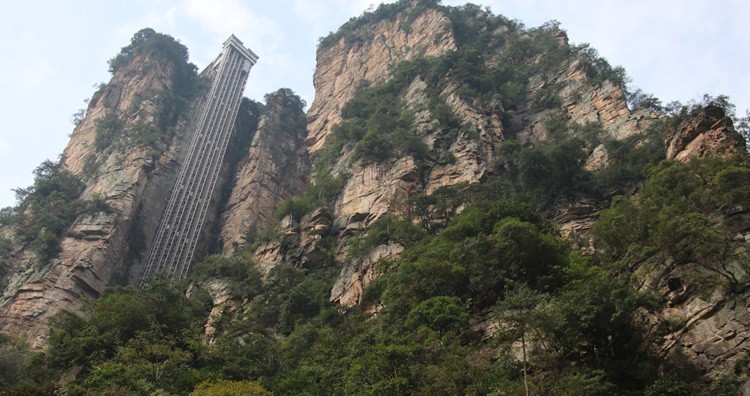
Riding an elevator situated at the edge of a cliff seems a bit daring. And when its entirely made of glass and is 326 meters (1,070 ft) in height, it’s more than just daring! The Bailong Elevator in Zhangjiajie, China is the place where you can get such an experience. You can buy a ticket and ride to the top of the cliff and enjoy the view from there. The elevator system is situated on a sandstone cliff through which tunnels have been dug for people to reach the area that has three, glass, double-decker elevators. The elevator has gained the tag of being the tallest and the heaviest outdoor elevator in the world in the Guinness Book of World Records.
The construction for the Bailong Elevator started in 1999 and was opened to the public in 2002. Many environmentalists have been debating on the environmental effects of the elevator as the site on which it was constructed was claimed as a World Heritage Site. So far, there have been no environmental concerns. The elevator was stopped from working briefly for 10 months between 2002-2003 due to safety concerns. (1, 2)
10. The Venice Tide Barrier Project consists of 78 rotating gates designed to keep the sea waters from entering the Venetian Lagoon. Each gate is filled with water and rests at the bottom of the sea. During high tides, the gates are emptied using compressed air, and they rise to the top blocking the water from entering the lagoon.

Venice is the most romantic city in the world, but it is not short of problems. The city has suffered too many losses from floods with the level of flood water increasing every year. So, to protect the city from high tides, the government thought of an innovative approach. Known as the “MOSE” scheme, or the “Modulo Sperimentale Elettromeccanico” or “Electromechanical Experimental Module” scheme, the idea was to create an artificial barrier that would protect the city from future, massive floods.
The system they designed turned out to be incredible. It is comprised of a series of inflatable and oscillating flood gates filled with water that are placed strategically on the floor of the three main inlet lagoons. When the weather predicts a high tide over three meters (9.8 feet), air is pumped into the inflatable gates until all the water inside is forced out, and they rise up to the surface. The rise protects the inlet lagoons from the high tide. Once the tide descends, air is pumped in forcing the water out, and the gates submerge.
The system currently has 78 gates, each 6,500 sq. ft in size, in place, and the system is set to be fully completed by 2022. (1, 2, 3)


Comment (0)